History of the Levallois-Perret Citroën Factory in Paris
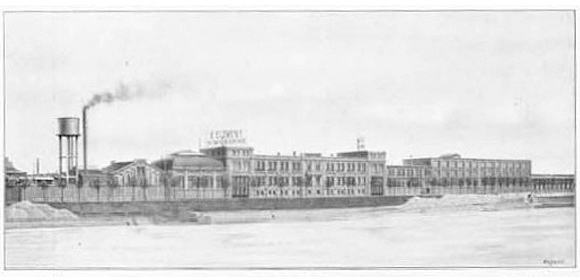
Aside from the first Citroën factory built at Quai de Javel in Paris, just 3 kilometers from the Eiffel Tower, an equally historic Citroën manufacturing plant, the Levallois-Perret factory, was located in a suburb of the French capital, just 6 km from the center of Paris in Levallois-Perret on the right bank of the Seine river, in the department of Hauts-de-Seine. It has the distinction of being the longest operating Citroën factory in Paris.
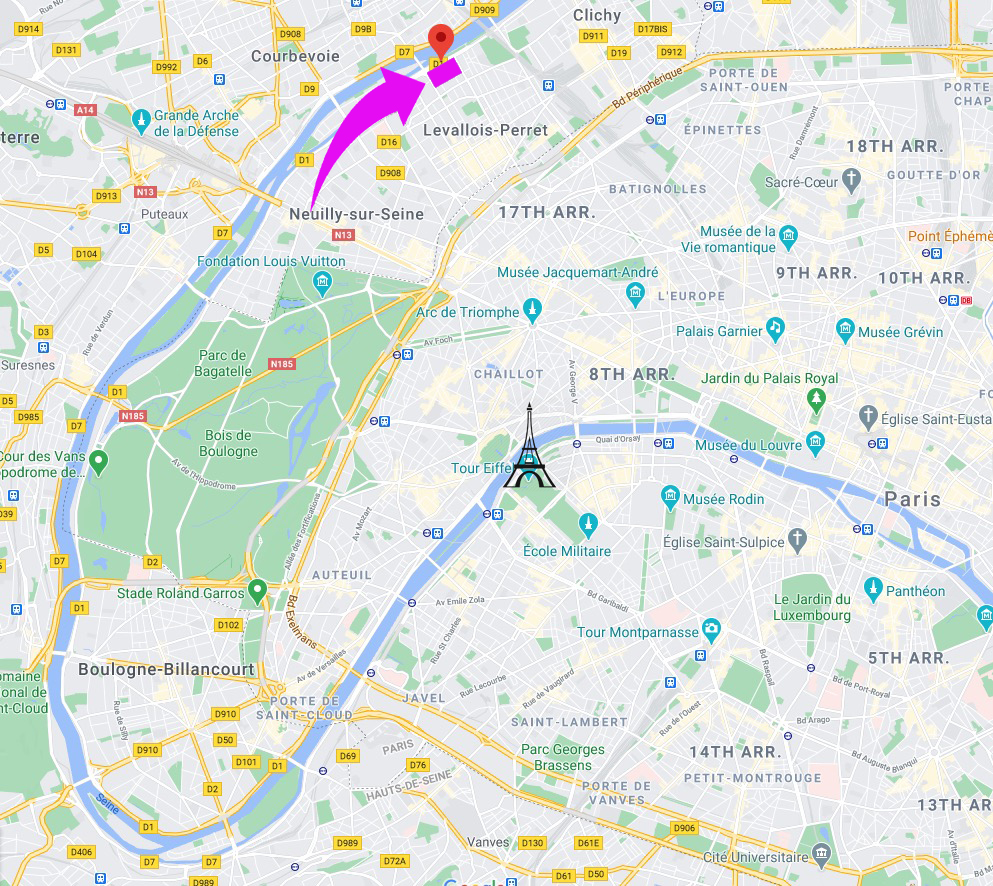
The history of the factory is fascinating and can be traced back to Gustave Adolphe Clément, whose businesses in bicycles, automobiles, airplanes and tires were all factors in it’s creation.
Gustave Adolphe Clément, (September 22, 1855 – March 10, 1928), was a French entrepreneur who went on to race and manufacture bicycles, pneumatic tyres, motorcycles, automobiles, aeroplanes and airships. An orphan (his mother died when he was seven years old and although his father remarried he also died 2 years later when Adolphe was nine years old) he became a blacksmith and a ‘Compagnon du Tour de France’.

In 1876, after 2 years of cycle racing, working and saving, Adolphe, at age 21, had enough money to start in business, so he opened a bicycle repair works in Bordeaux. The next stage of his business plan was to move to Marseilles where he learned how to manufacture steel tubes for bicycles. The following year he moved to Lyon and began manufacturing whole bicycles under the name ‘Clément SA cycles’.
In 1878 he moved to Paris and opened a cycle business, A. Clément & Cie, at 20 Rue Brunel near the Place de l’Etoile. There he also ran a cycling school and was competing in cycle races. In Paris his business backers were monsieur de Graffenried and monsieur de Montgeron.
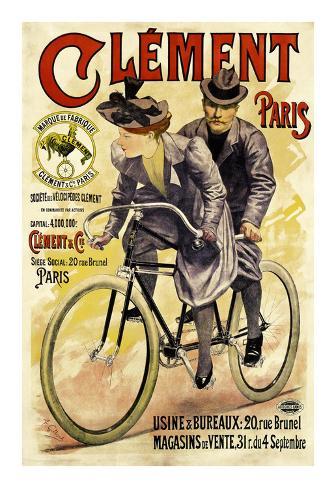
Also in 1878 Clément began the manufacture of Clément Tyres to fit to the early cycles, but in 1889 Clément saw a Dunlop pneumatic tyre in London and acquired the French manufacturing rights for 50,000 francs. This success led to his millionaire status. The company he formed with a capital of 700,000 francs paid 100 per cent dividend in its first year of operation. The Clément Tyres French identity was lost with the overwhelming success of his Dunlop pneumatics.
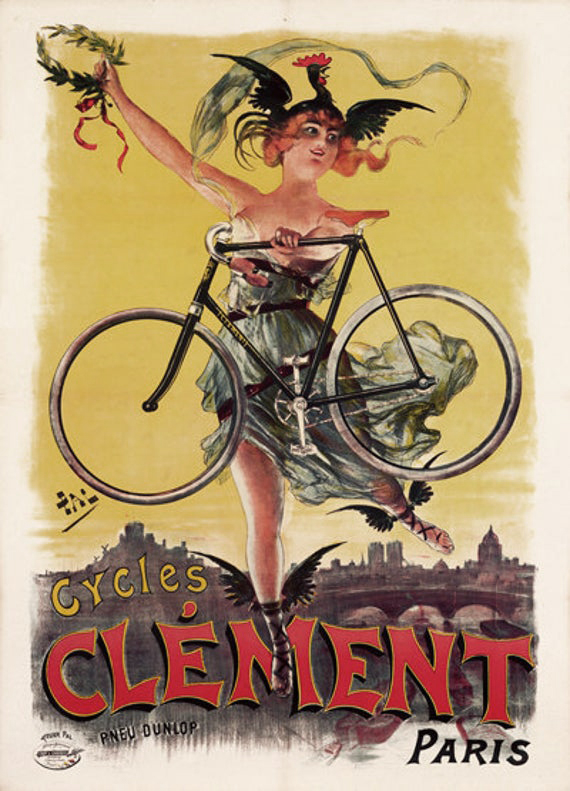
By 1880 the “Clément” cycle manufacturing business at Rue Brunel, had circa 150 employees building what were regarded as high-quality bicycles and by 1890 Clément was the leading cycle brand in France.
The Gladiator Cycle Company, a French bicycle manufacturer, was founded by Alexandre Darracq and Paul Aucoq in 1891 at Le Pré-Saint-Gervais in northeast Paris. Adolphe Clément was a major investor in this venture.
In 1894 Clément started construction work on a former military site in the Faubourg Saint-Julien at Mézières, to build a new factory, which would become known as La Macérienne, to produce components and spokes for the Gladiator Cycle Company. It covered 15,000 square meters and housed a hydraulic turbine power plant, a steam room, a large machine hall, a foundry, and a workshop for nickel processing. (The factory building still exists but in the spring of 2006 it was transformed into a cultural center.) .

Gustave Adolphe Clément’s first foray into automobiles came in 1894 when he was a passenger in the winning vehicle in the world’s first competitive motor event. Albert Lemaître’s Peugeot was judged to be the winner of the Paris–Rouen Competition for Horeseless Carriages (Concours des Voitures sans Chevaux).

From 1895 Clément cycles started to focus on motorized vehicles. In 1895 it introduced its first internal combustion vehicle, a naphtha powered tricycle.
In 1896 Adolfe Clément began to build another new factory at Levallois-Perret in north west Paris. This produced cycles and various cars from 1898, (Clément-Panhard, Clément-Gladiator from 1901, Clément-Bayard from 1903).
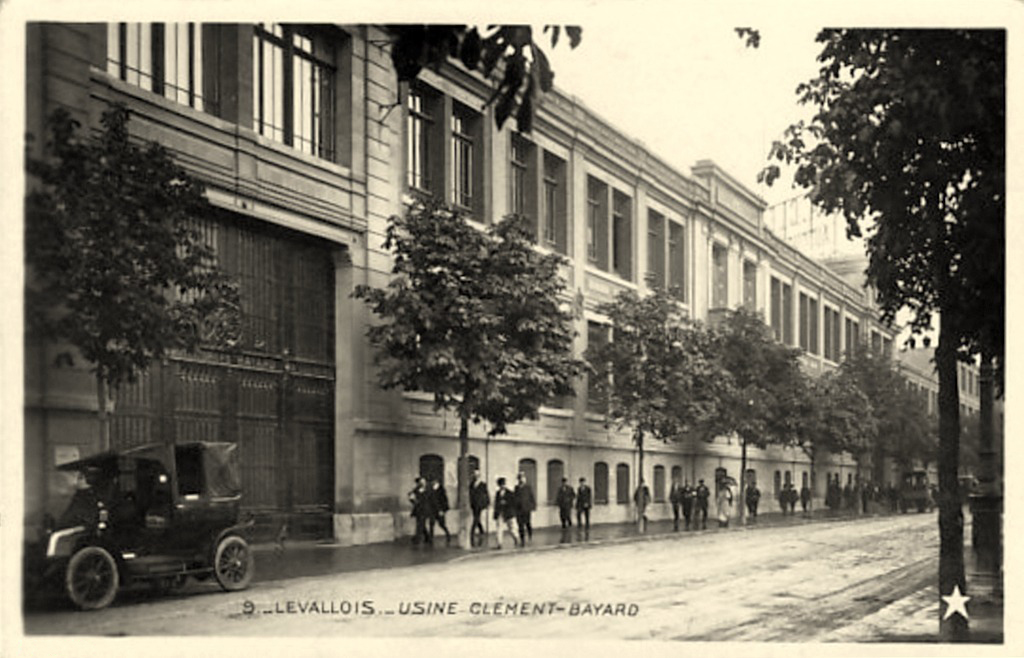
In 1897 Clément invested one million francs (the equivalent of about three 3 million Euros at 2006 valuation) in Panhard & Levassor, part of their five million francs capitalization. This established the main business and eventually led to the creation of Clément-Panhard marque. Clément was a director of Panhard & Levassor, and when the factory could not meet the production requirements for 500 units of the 1898 ‘voiture légère’ (‘dog cart’) model, he undertook manufacture under license at his factory in Levallois-Perret.
By 1898 the Clément-Gladiator company was building cars and marketing them as both Cléments and Gladiators. Gladiators were imported into England by the Motor Power Company, which was co-owned by S. F. Edge and Harvey du Cros founder of Dunlop.
In 1902 they offered a motorized bicycle with a 142 cc engine bolted to the frame, using overhead valves and a detachable cylinder head; the inlet valve ‘automatic’ (controlled by engine suction), the exhaust valve mechanically operated. A coil-and-battery ignition was used, and a two-barrel carburetor controlled by small levers attached to the frame top tube. An external flywheel kept the crankcase very small, and a long belt from the engine pulley to a ‘dummy’ rim on the rear wheel was tensioned by a small ‘jockey’ pulley on the seat tube. The front brake pressed direct on the front tire, the rear was a ‘coaster’ brake activated by back-pedaling. This ‘motorisation adaptation’ was sold on both Clément and Gladiator cycles.
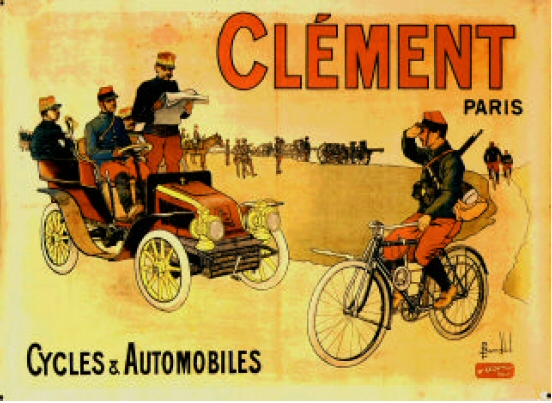
From 1901 Clément-Gladiator cars were built at the Levallois-Perret factory and by 1902 production was over 1,000 cars per annum, 800+ of which were sold in England. (Financed by Harvey du Cros Herbert Austin built Clement-Gladiator cars at Longbridge, south-west Birmingham, England, from early 1906, selling them as Austin cars.)
As a result of selling the manufacturing rights to his Clément vehicles, Clément-Gladiator was divided in 1903, with Charles Chetwynd-Talbot founding the English arm “Clément-Talbot Ltd”, while Adolphe Clément formed Clément-Bayard, adding Bayard to the name of his new business. The company name honoured the Chevalier Pierre Terrail, seigneur de Bayard who saved the company’s town of Mézières from an Imperial army during the Siege of Mézières in 1521.
From 1904 Clément-Bayard production at Levallois-Perret increased from 1,800 cars per annum to 3,000 in 1907, employing up to 4,000 workers. The range included several models, all luxurious and high quality, from a small two-seater twin-cylinder 8-10 hp to a big four-cylinder 50-60 hp model that could exceed 60 km/h. In 1907 the 10/12 hp model was introduced with a unitary gearbox and a dashboard radiator. In 1910 Clément-Bayard started to manufacture a stylish, low cost, small, two-seater roadster, with a 4-cylinder 10/12 hp, and a heater for the driver and passenger. It was very popular and production continued until the outbreak of war in 1914.
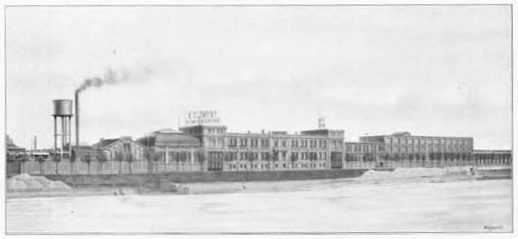
Clément-Bayard was also an early French manufacturer of aircraft engines and lighter-than-air vehicles, with the earliest flights occurring in 1908. The company worked with Louis Capazza to produce the ‘planeur (glider) Bayard-Clément’ which was unveiled in L’Aérophile (magazine) on 15 May 1908.
Clément-Bayard built a monoplane (Demoiselle No 19 ) that world aviation pioneer Alberto Santos-Dumont designed and built to compete for the Coupe d’Aviation Ernest Archdeacon prize from the Aéro-Club de France. It was the world’s first series production aircraft and by 1909 Clement-Bayard had the license to manufacture Wright engines alongside their own design.

By 1913 the factories of Levallois and Mezieres were focused on the production of a wide range of products including car chassis, car bodies, cars, trucks, airships, airplanes, motors, canoes, bicycles, engines and generators.
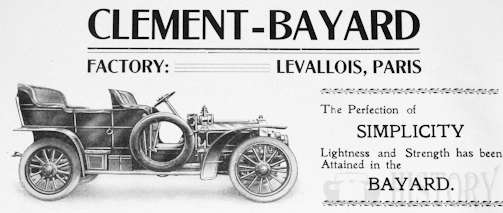
In 1914 the factory La Macérienne at Mézières was seized by the advancing German army. Adolphe Clément ceded control of Clément-Bayard to his son Maurice in early 1914, but the consequences of World War I for the company were disastrous. The machinery in the La Macérienne factory at Mézières was shipped back to Germany, and the forges, foundries and smelter were destroyed. The gutted building was used as an indoor riding school for German officers.
Meanwhile, automobile manufacture at Levallois-Perret in Paris, was suspended as the factory was turned over to wartime production of military equipment; vehicles; aircraft engines; airships; and planes.
Enter André Citroën. After constructing the Quai de Javal factory in Paris during WW1 for the production of munitions, he converted it to automobile production in 1919. Citroën’s mandate was characteristically demanding and characteristically simple: to produce an all-new design for a 10 HP car that would be better equipped, more robust and less costly to produce than any rival product at the time. The result was the Type A, announced to the press in March 1919, just four months after the guns fell silent. The first production Type A emerged from the Quai de Javal factory at the end of May 1919. André was on his way to have S.A. André Citroën become the largest automobile manufacturer in Europe at the time.
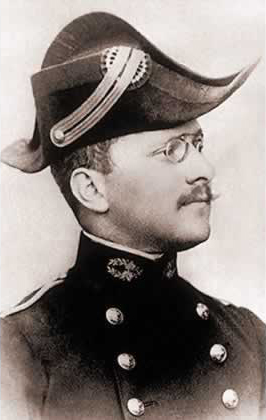
By 1921, Citroën had gained enough popularity to become an element of the Parisian lifestyle. The first Citroën Taxis appeared, followed by the release of a newer car model, the Type C, also available in a three seater version called ‘Le Trefle’ (Clover Leaf) which garnered a lot of acclaim.
In 1922 the Clément-Bayard automobile company was sold to André Citroën, in whom Adolphe Clément also invested financially. The factory at Levallois-Perret produced such models as the B12 in 1925 , the B14 in 1927 and in the beginning of the 1930s, the C4 and the C6.
Interesting sidenote: Henri Chapron had established his coachworks company during the 1920s creating custom-car bodies for luxury French marques such as Delage, Delahaye and Talbot in his garage in Levallois Perret.
Commencing in 1947, the 2CV would be manufactured there for over 40 years.
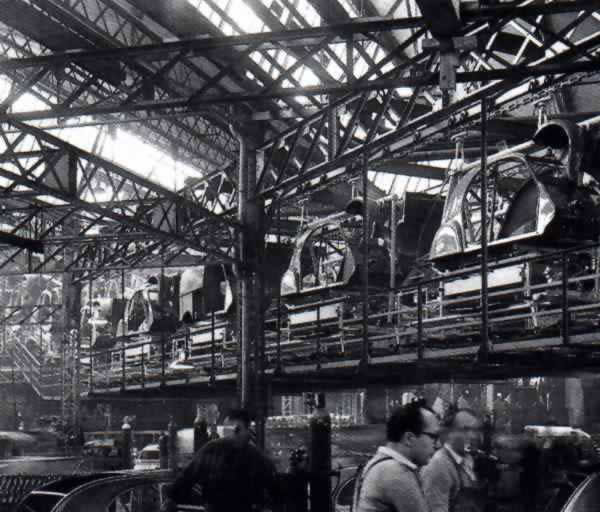
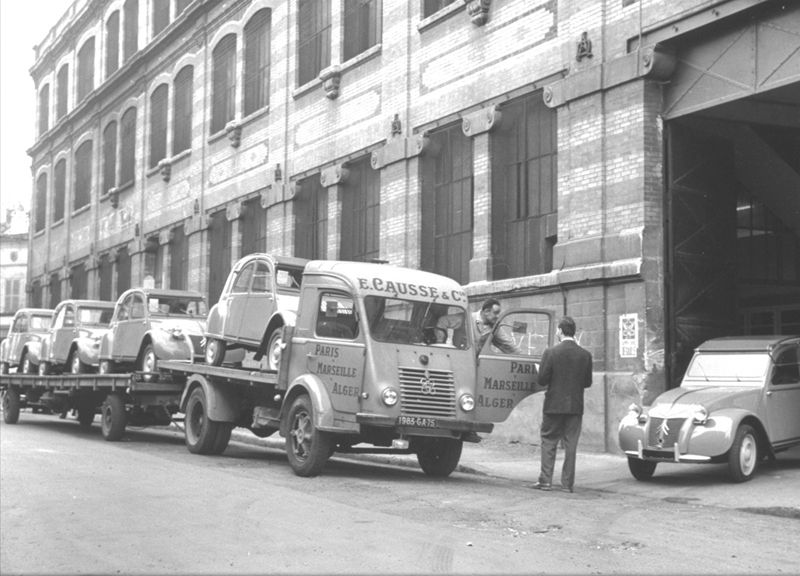
In the UK Channel 4 documentary “The Tin Snail” from 1986, it shows new 2CVs exiting through a side door at Rue du Président Wilson, with temporary plates attached to their trunk lids for the brief drive down to the Seine loading area.
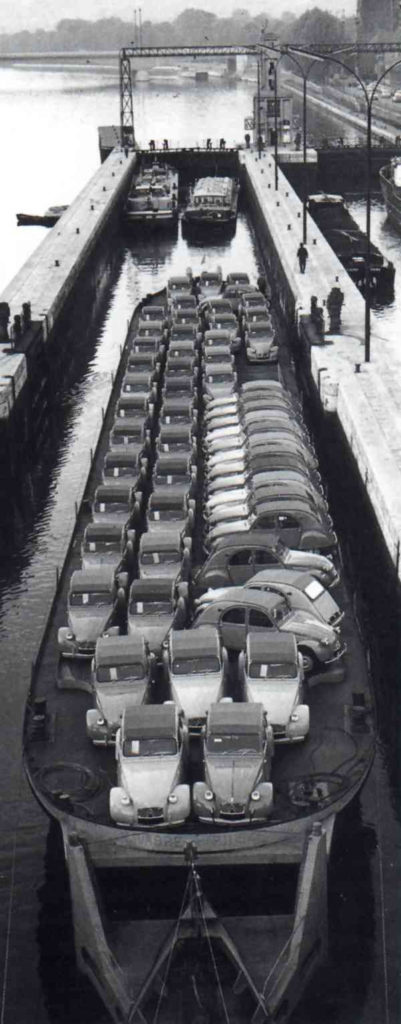
The factory at Levallois-Perret had been the global centre for 2CV production since 1948 but was outdated, inefficient and widely criticized for its poor working conditions.

The last French built 2CVs were produced at the Levallois-Perret plant on Friday, Feb. 26. 1988 and the final cars rolled out on Monday Feb. 29.
Citroënvie member Gert Bue Larsen was there on both of those days with some friends watching the last few 2CVs leave the factory. He recalls that they were driven without plates a few hundred meters along then Quai Michelet down to what is now the Quai Charles-Pasqua park area by the Seine and loaded on to car carrier trucks, which took them to the “new car storage” area at Aulnay.

Very interesting story ! As a new and young engineer I worked at Citroen from July 1964 to March 1965 . I was based at the Nanterre plant ( formerly Donnet – Zedel ) and had the opportunity to go to Levallois and Quai de Javel many times as well as Saint Charles ( gear boxes ) . I did not know the complete story of Levallois. Thank you !
After this learning period I worked 7 years for Matra Automobiles which just started.
Philippe Santini
Hola, mi padre fue un inmigrante español que estuvo trabajando como montador en la fábrica de Levallois desde marzo de 1964 hasta marzo de 1965. Antes había trabajado en la fábrica de SIMCA en Poissy desde diciembre de 1961 a diciembre de 1963. Su domicilio estaba en Rue vieux chemin d´Argenteuil en Gennevillliers. Supongo que esto era en los terrenos del puerto. Agradecería cualquier información las condiciones de vida de los emigrantes en este tiempo.
Gracias
Translation: Hello, my father was a Spanish immigrant who was working as an assembler in the Levallois factory from March 1964 to March 1965. He had previously worked at the SIMCA factory in Poissy from December 1961 to December 1963. His address was at Rue vieux chemin d´Argenteuil in Gennevillliers. I assume this was on the harbor grounds. I would appreciate any information on the living conditions of the emigrants at this time.
Thanks
What happened to the factory building?
It was built in 1903 by Adolphe Clément, head of Automobiles Clément-Bayard and as far as we can determine, the address was 54 quai Michelet. Today there is a modern multi-story building on the site, so it would appear the the factory was demolished to make way for it.
Mon grand père maternel russe blanc y a travaillé vers lès année 1928-1930 j’aimerais retrouver sa trace dans les fichiers des archives de l’usine . Comment faire ?
Translate: My white Russian maternal grandfather worked there around the year 1928-1930, I would like to find his trace in the files of the factory archives. How to do ?
L’entreprise a conservé plusieurs milliers de dossiers au Conservatoire Citroën. Vous voudrez peut-être essayer de les contacter :
PSA PEUGEOT CITROËN
Conservatoire Citroën – CC AN81
Bd André Citroën – BP 13
93601 AULNAY SOUS BOIS CEDEX – FRANCE
tél : + 33 1 56 50 80 22
télécopie : + 33 1 56 50 80 23
email : conservatoire@citroen.com
Merci pour ces informations, je vais les contacter.
Is there a sign or plaque to mark the place? I was thinking of taking my 2CV back there!
Yes, you can see it in this article we wrote about the former factory site back in July 2022. It is now Parc André Citroën. https://citroenvie.com/parc-andre-citroen/